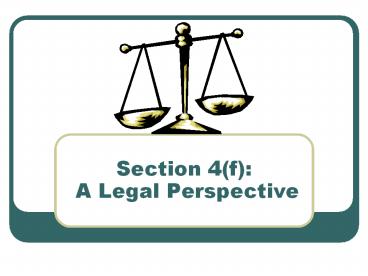Section 4(f): A Legal Perspective - PowerPoint PPT Presentation
1 / 21
Title:
Section 4(f): A Legal Perspective
Description:
The Supreme Court established a high standard for the 'prudent and feasible' statutory language. ... Louisiana Environmental Society v. Coleman; 537 F.2d 79 ... – PowerPoint PPT presentation
Number of Views:99
Avg rating:3.0/5.0
Title: Section 4(f): A Legal Perspective
1
- Section 4(f) A Legal Perspective
2
Substantive v. Procedural
- Section 4(f)
- is Substantive
- More than a process
- Requires a certain outcome
- NEPA
- is Procedural
- No specific outcome required
- Any alternative can, in theory, be selected
3
Law - 49 U.S.C. 303(c)
- The Secretary may approve a transportation
program or project requiring the use of publicly
owned land of a public park, recreation area, or
wildlife and waterfowl refuge, or land of an
historic site of national, State, or local
significance only if - - there is no prudent and feasible alternative to
using that land and - the program or project includes all
possible planning to minimize harm .
4
Regulations - 23 CFR 771.135
- (a)(i) The Administration may not approve the use
of land from a significant publicly owned public
park, recreation area, or wildlife and waterfowl
refuge, or any significant historic site unless a
determination is made that - (ii) There is no prudent and feasible alternative
to the use of land from the property and - (iii) The action includes all possible planning
to minimize harm to the property resulting from
such use.
5
Case Law !
6
Feasible and Prudent
Citizens to Preserve Overton Park v. Volpe, 401
U.S. 402 (1971) The Supreme Court established a
high standard for the prudent and feasible
statutory language.
7
Key Overton Park Language
The few green havens that are public parks were
not to be lost unless there were truly unusual
factors present in a particular case or the cost
or community disruption resulting from
alternative routes reached extraordinary
magnitudes. If the statutes are to have any
meaning, the Secretary cannot approve the
destruction of parkland unless he finds that
alternative routes present unique problems.
8
Feasible
Feasible Technically Possible
- An alternative is not feasible
- only if as a matter of sound engineering
- it would not be feasible to build the
- highway along any other route.
9
Prudent
- Unique problems
- Unusual factors
- Extraordinary magnitude
10
23 CFR 771.135(a)(2)
- Supporting information must demonstrate that
there are unique problems or unusual factors
involved in the use of alternatives that avoid
these properties or that the cost, social,
economic, and environmental impacts, or community
disruption resulting from such alternatives reach
extraordinary magnitudes.
11
Louisiana Environmental Society v. Coleman537
F.2d 79 (5th Cir. 1976)The law in the
5th and 11th Circuits (and essentially
the 9th)
The Black Box Test
Any park use, regardless of degree, invokes
4(f).
12
Stop H-3 Assn v. Coleman 533 F.2d 434 (9th
Cir.), cert. denied, 429 U.S. 999 (1976)
Historic Sites
If historic site is eligible for National
Register, locals cannot declare site
insignificant.
13
Timing of Determination
- Corridor H Alternatives, Inc. v. Slater 166 F.3d
368 (D.C. Cir. 1999) - -- FHWAs Section 4(f) regulations do NOT allow
the agency to postpone the final Section 4(f)
determination until after issuance of the ROD.
14
Extraordinary Magnitude
Stop H-3 v. Dole 740 F.2d 1442 (9th Cir. 1984),
cert. denied, 471 U.S. 1108 (1985)
- 31 residences, 1church, and 4 business
relocations - Increased cost of 42 million (386 million
budget) - Increased noise, air quality, and visual impacts
to residences in the vicinity - NOT
- Community disruption of extraordinary magnitude
15
Cumulative Drawbacks
Eagle Foundation v. Dole 813 F.2d 798 (7th Cir.
1987) -- Said the Supreme Court was merely being
emphatic in using word unique.
- A prudent judgment by
- an agency is one that takes into account
- everything important that matters.
16
Eagle Foundation v. Dole
- Courts main holding became FHWA policy
- When making a finding that an alternative is not
feasible and prudent, it is not necessary to show
that any single factor presents unique problems.
Adverse factors such as environmental impacts,
safety and geometric problems, decreased traffic
service, increased costs, and any other factors
may be considered collectively.
- FHWA Policy Paper
17
Purpose and Need
- Arizona Past and Future Foundation v. Lewis 772
F.2d 1423 (9th Cir. 1983)
- Alternatives that do not
- meet the purposes of the project may
- properly be rejected as imprudent.
An alternative that does not meet purpose and
need is de facto imprudent.
18
Programmatic Evaluations
- Friends of the Pioneer Street Bridge v. FHWA 150
F.Supp. 2d 637 (D. Vt. 2001) - -- Upheld use of Nationwide Programmatic
Agreement for Historic Bridges - -- First (and only) case to involve use of a
programmatic 4(f)
19
Section 4(f) Evaluations
- No self-serving or unsupported statements in
prudency determinations For example - -- Avoidance Alt. A would not be prudent because
it would cost too much. - -- Avoidance Alt. B would not be prudent
because it would have greater
environmental impacts than the Preferred
Alternative.
20
The Eagle Foundation Method
- Look at the cumulative effect of
- Additional Costs
- Social impacts
- Economic impacts
- Environmental impacts
- Community disruption .
21
Remember Overton Park!
- Unique problems
- Unusual factors
- FHWA Website
- http//www.environment.fhwa.dot.gov/projdev/pd5sec
4f.asp































